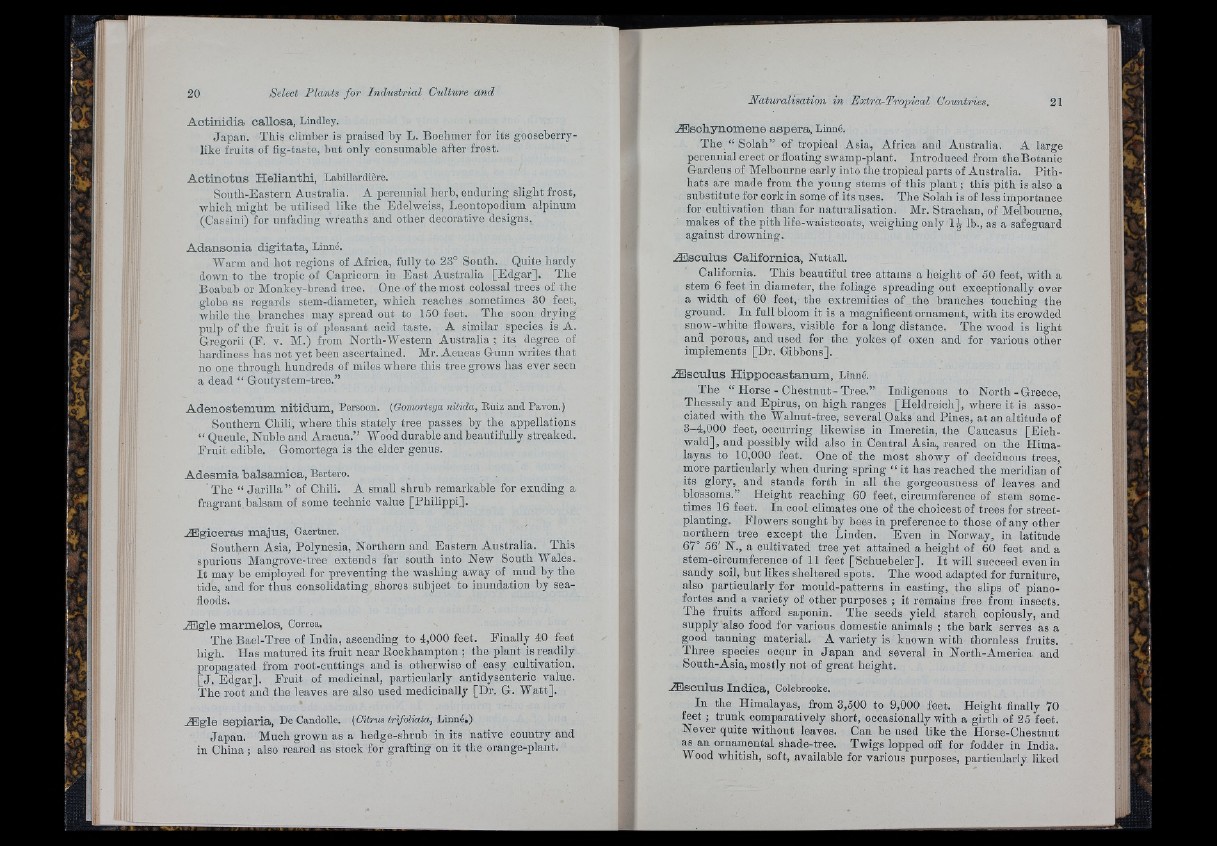
A o tin id ia ca llo sa , Lindley.
Japan. This climber is praised by L. Boehmer for its gooseberrylike
fruits of fig-taste, but only consumable after frost.
A o tin o tu s H e lia n th i, Labillardière.
South-Eastern Australia. A perennial herb, enduring slight frost,
which might be utilised like the Edelweiss, Leontopodiiim alpinum
(Cassini) for unfading wreath.3 and other decorative designs.
A d a n s o n ia d ig ita ta , Linné.
Warm aud hot regions of Africa, fully to 23° South. Quite hardy
down to the tropic of Capricorn in E a st Australia [E d g a r]. The
Boahab or Monkey-bread tree. Cne of the most colossal trees of the
globe as regards stem-diameter, which reaches sometimes 30 feet,
while the branches may spread out to 150 feet. The soon drying
pulp of the fruit is of pleasant acid taste. A similar species is A.
Gregorii (F. v. M.) from North-Western Australia ; its degree of
hardiness has not yet been ascertained. Mr. Aeneas Gunn writes th a t
no one through hundreds of miles where this tree grows has ever seen
a dead “ Goutystem-tree.”
A d e n o s tem um n itid um , Persoon. {Gomortega nitida, Ruiz and Pavon.)
Southern Chili, where this stately tree passes by the appellations
“ Queule, Nuhle and Aracua.” Wood durable and beautifully streaked.
F ru it edible. Gomortega is the elder genus.
A d e sm ia b a ls am io a , Bertero.
The “ J a r illa ” of Chili. A small shrub remarkable for exuding a
fragrant balsam of some technic value [Philippi].
Æ g io e r a s m a ju s , Gaertner.
Southern Asia, Polynesia, Northern and Eastern Australia. This
spurious Mangrove-tree extends far south into New South Wales.
I t may be employed for preventing the washing away of mud by the
tide, and for thus consolidating shores subject to inundation by sea-
floods.
Æ g le m a rm e lo s , Correa.
The Bael-Tree of India, ascending to 4,000 feet. Finally 40 feet
high. Has matured its fruit near Rockhampton ; the plant is readily
M’opagated from root-cuttings and is otherwise of easy cultivation.
‘J . Edgar]. Fruit of medicinal, particularly antidysenteric value.
The root and the leaves are also used medicinally [Dr. G. Wa tt],
Æ g le s e p ia ria , De Candolle. (Citrus trifoliata, Linné,)
Japan. Much grown as a hedge-shrub in its native country and
in China ; also reared as stock for grafting on it the orange-plant.
.^ s o h y n om e n e a sp e ra , Linné.
The “ Solah” of tropical Asia, Africa and Australia. A large
perennial erect or floating swamp-plant. Introduced from the Botanic
Gardens of Melbourne early into the tropical parts of Australia. Plth-
hats are made from the young stems of this p la n t; this pith is also a
substitute for cork in some of its uses. The Solah is of less importance
for cultivation than for naturalisation. Mr. Strachan, of Melbourne,
makes of the pith life-waistcoats, weighing only lb., as a safeguard
against drowning.
JE s c u lu s C a lifo rn ic a , Nuttall,
California. This beautiful tree attains a height of 50 feet, with a
stem 6 feet in diameter, the foliage spreading out exceptionally over
a width of 60 feet, the extremities of the branches touching the
ground. In full bloom it is a magnificent ornament, with its crowded
snow-white flowers, visible for a long distance. The wood is light
and porous, aud used for the yokes of oxen and for various other
implements [Dr. Gibbons].
2E so u lu s H ip p o c a s ta n um , Linné.
The “ Horse - C h e stn u t-T re e .” Indigenous to North-Greece,
Thessaly aud Epirus, on high ranges [Heldreich], where it is associated
with the Walnut-tree, several Oaks and Pines, a t an altitude of
3-4,000 feet, occurring likewise in Imeretia, the Caucasus [Eieh-
wald], and possibly wild also in Central Asia, reared on the Himalayas
to 10,000 feet. One of the most showy of deciduous trees,
more particularly when during spring “ it has reached the meridian of
its glory, and stands forth in all the gorgoousness of leaves and
blossoms.” Height reaching 60 feet, circumference of stem sometimes
16 feet. In cool climates one of the choicest of trees for street-
planting. Flowers sought by bees in preference to those of any other
northern tree except the Linden. Even in Norway, in latitude
67° 56' N., a cultivated tree yet attained a height of 60 feet and a
stem-circumference of 11 feet [Schnebeler]. I t will succeed even in
sandy soil, but likes sheltered spots. The wood adapted for furniture,
also particularly for mould-patterns in casting, the slips of pianofortes
and a variety of other purposes ; it remains free from insects.
The fruits afford saponin. The seeds yield starch copiously, aud
supply also food for various domestic animals ; the bark serves as a
good tanning material. A variety is known with thornless fruits.
Three species occur in Jap an and several in North-America and
South-Asia, mostly not of great height.
jffilsculus In d ic a , Colebrooke.
In the Himalayas, from 3,500 to 9,000 feet. Height finally 70
feet ; trunk comparatively short, occasionally with a girth of 25 feet.
Never quite without leaves. Can be used like the Horse-Chestnut
as an ornamental shade-tree. Twigs lopped off for fodder in India.
Wood whitish, soft, available for various purposes, particularly liked